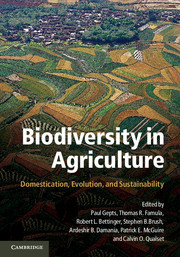Book contents
- Frontmatter
- Contents
- Tables
- Figures
- Foreword
- Contributors
- Acknowledgments
- Introduction: The Domestication of Plants and Animals: Ten Unanswered Questions
- 1 The Local Origins of Domestication
- Section I Early Steps in Agricultural Domestication
- Section II Domestication of Animals and Impacts on Humans
- Section III Issues in Plant Domestication
- Section IV Traditional Management of Biodiversity
- Section V Uses of Biodiversity and New and Future Domestications
- 22 Participatory Domestication of Indigenous Fruit and Nut Trees: New Crops for Sustainable Agriculture in Developing Countries
- 23 The Introduction and Dispersal of Vitis vinifera into California: A Case Study of the Interaction of People, Plants, Economics, and Environment
- 24 Genetic Resources of Yeast and Other Micro-Organisms
- 25 Biodiversity of Native Bees and Crop Pollination with Emphasis on California
- 26 Aquaculture, the Next Wave of Domestication
- 27 Genetic Sustainability and Biodiversity: Challenges to the California Dairy Industry
- Index
- References
25 - Biodiversity of Native Bees and Crop Pollination with Emphasis on California
Published online by Cambridge University Press: 05 June 2012
- Frontmatter
- Contents
- Tables
- Figures
- Foreword
- Contributors
- Acknowledgments
- Introduction: The Domestication of Plants and Animals: Ten Unanswered Questions
- 1 The Local Origins of Domestication
- Section I Early Steps in Agricultural Domestication
- Section II Domestication of Animals and Impacts on Humans
- Section III Issues in Plant Domestication
- Section IV Traditional Management of Biodiversity
- Section V Uses of Biodiversity and New and Future Domestications
- 22 Participatory Domestication of Indigenous Fruit and Nut Trees: New Crops for Sustainable Agriculture in Developing Countries
- 23 The Introduction and Dispersal of Vitis vinifera into California: A Case Study of the Interaction of People, Plants, Economics, and Environment
- 24 Genetic Resources of Yeast and Other Micro-Organisms
- 25 Biodiversity of Native Bees and Crop Pollination with Emphasis on California
- 26 Aquaculture, the Next Wave of Domestication
- 27 Genetic Sustainability and Biodiversity: Challenges to the California Dairy Industry
- Index
- References
Summary
The often-cited estimate that about 30% of our diet depends directly or indirectly on crops pollinated by animals (McGregor 1976) may not hold with more recent and future analyses (Klein et al. 2007). But much of the variety in our diet beyond staples such as wind-pollinated grains depends on animals, especially bees, for pollination. Such pollinator-dependent crops include many fruits (pome, stone), berries (cane, bramble), cucurbits (melons, squashes), nuts (almond, macadamia) and vegetable, oil, and forage crop seeds.
Analyses of primary data from 200 countries found that over 75% of 87 globally important food crops (fruits, vegetables, and seeds) are dependent on animal pollination (Klein et al. 2007). These authors state that this represents about 35% of human food production. They also evaluated habitat management for pollination for nine crops and found that intensification of agriculture put wild bees and pollination services at risk. However, analyses of FAO data by Aizen et al. (2008) show similar trends of increased yields in both pollinator-dependent and nondependent crops. They conclude that this does not support the contention that animal-pollinated crops are currently being affected by pollinator shortages at a global scale. However, they warn that if the disproportionate increase in area cultivated with pollinator-dependent crops continues, dependency on services from dwindling pollinator populations will increase in future.
- Type
- Chapter
- Information
- Biodiversity in AgricultureDomestication, Evolution, and Sustainability, pp. 526 - 537Publisher: Cambridge University PressPrint publication year: 2012
References
- 2
- Cited by



